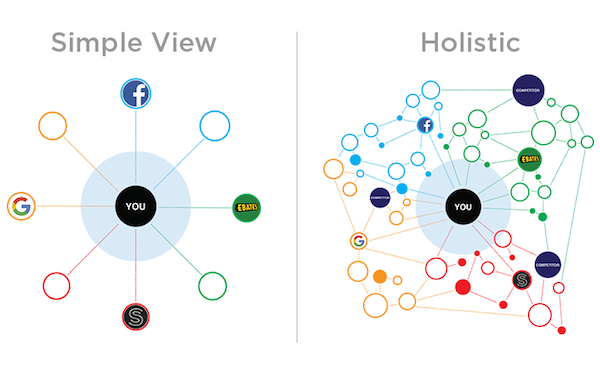Flying home from the Semantic Technology Conference 2009 (#semtech2009 on Twitter), I have to confess that I’m drunk on the Kool-Aid.
My presentation on marketing in the semantic web attracted a packed room, and feedback — from both technical and business attendees — was incredibly positive. But it was the sum of the rest of the conference that really inspired me to conclude:
The semantic web — or web of data, web 3.0 if you prefer — is inevitable.
Now, I’ve been an advocate of the semantic web, and particularly how it might impact the marketing department (“semantic marketing“), for a while. But I tempered my enthusiasm with reservations about how and when it would come to be. After 20 years working in disruptive technology businesses, one develops a certain pragmatism about the “breakthroughs” that never quite break through.
But now I’m throwing off my skeptic’s cloak.
Enough of the technical standards are in place, with enough consensus across academia and business, to serve as a stable foundation. Sure, there will be tweaks, refinements, enhancements. But the core of this technology has enough critical mass and momentum behind it to provide a solid, standardized base upon which the next round of innovation can be built.
It’s analogous to the shift that happened in the original web once browsers and web servers reached agreement on things like secure SSL connections, cookies, etc., where the web sprang from being an interesting technology experiment into a full-throttle, commercialized Zeitgeist that hasn’t slowed down since.
But having a technology mature into useable adolescence is merely a necessary but not sufficient requirement to guarantee a worldwide revolution.
The real reason why the semantic web is inevitable at this point is because the business potential of a web of data — inside the enterprise and out in the public web — is becoming obvious and immense.
Businesses are data-driven. They have been ever since the rise of IT. But that has become a curse, as the far majority of raw data wastes away in silos — unanalyzed, unintegrated, and never refined into valuable, actionable intelligence. The semantic web can take these stagnant pools of data and connect them into streams, rivers, and oceans — from across the enterprise or around the world — in ways that people can harness on demand to answer quantifiable or complex data-driven questions and to construct a new generation of automated and “intelligent” software agents that can reason reasonably well.
This will juice operations and IT — who are already some of the early adopters of semantic web technologies to accomplish their existing needs with less overhead. And there’s a synergy between data web standards and the movement toward cloud computing and on-demand infrastructure and applications — they each make the other more valuable and practical, a nice virtuous cycle. That alone could justify widespread adoption.
But that’s only the tip of the iceberg. The big enchilada is the potential this has for marketing — and I mean marketing in the broadest sense possible. Creating better customer experiences. Bonding more tightly with your market. Becoming a big, branded authority in the domain you seek to own.
How?
Because your customers’ businesses are data-driven too, and through the semantic web, you can supply them with data that can be highly beneficial to their operations — connecting their businesses up to your intravenous drip of miracle data goodness. You help them perform better by giving them a piece of the puzzle that you’re uniquely suited to provide. They then mash-up their own special blend of their data, your data, and other people’s data to achieve a whole new level of automation and intelligence in their world.
The marketers who deliver that to their audience will be golden — and that is the vision of data web marketing.
If you ever wished you had been at the forefront of the web, in the mid-90’s when pioneers shaped the landscape of e-commerce and online marketing for everyone else who followed, now is your chance. While the web of data will share many similarities with the regular web — indeed, the two will essentially merge into one continuous whole — it is also virgin territory. No one has ever used data web marketing as a competitive advantage before. Who will take the lead in your space? Who will claim first mover advantage? Who will grab the glory and the market share?
The sands in the hourglass are now running. The excitement of people who see this potential is palpable and infectious. And, as we’ve all become attuned to the quickening tempo by which web innovations are embraced and exploited, the incentives are there to act.
The semantic web isn’t just inevitable. It is imminent.



Hi Scott,
I sure wish I could have been in San Jose last week for your presentation (I was also very interested in Siri and others, but I was stuck here in the New York rain).
Your enthusiasm and kool-aid chugging is infectious. I have much the same kind of sense of apprehension for about what is about to happen. But I’m still at a loss to understand the impetus behind your strong homeward-bound beliefs of not only the inevitability, but imminence, of the web of data?
A good conference can generate a heady sense of momentum and history-in-the-making, but were there specific developments, companies, use-cases or initiatives that bolstered your enthusiasm?
Also, can you – without breaching agreements or copyrights — publish your presentation on your blog?
My best regards, and congratulations on the fine blogging.
Rob
Hi, Rob — thanks for the kind feedback!
My impression of the inevitability of this web of data came from two things at the conference:
1. The successful real world applications that had been implemented, albeit largely behind corporate firewalls in enterprise scenarios. This year there were some great case studies, not just theories about potential future case studies. While these intranet applications clearly benefited from being in controlled environments, it’s just not that much of a leap to see how it could work in the public web.
2. The sheer diversity of the different people involved in semantic web efforts, from Web 2.0 start-ups to academics to large corporations to research labs to cowboy hackers — it seemed like there were a tremendous number of independently blossoming seedlings. Even if some of them sputter or fade away, the odds of them all going quietly into the night seem low.
As for the imminence, which I’ll confess I have slightly less conviction about, I’m following two assumptions:
1. If it’s inevitable, then eventually everyone will be involved. It stands to reason therefore, that some of the people who get there first — particularly tool providers and Web 3.0 companies, if I can use that term with some loose definition — will be the next great success stories of our evolving Internet Age.
2. The speed by which new phenomena in the Internet Age are embraced seems to be faster every year. Google grew fast. eBay grew fast. Facebook grew faster. Twitter grew faster yet. Those aren’t just companies — they also represent the epitome of their respective ideas.
Putting those two things together, the incentives seem to be aligned for people to act. I suspect that’s why there were a number of VC’s at the conference, including the speaker for Sunday’s opening night ceremonies.
Maybe somebody slipped something into the water at the Fairmont, and we were all sharing the same hallucinations. (Hey, it is California, after all.) But I think there’s now some solid ground to go with that blue sky.
Time will tell!
The slide deck from my presentation is available in this post:
https://chiefmartec.com/2009/05/data-web-marketing-presentation.html